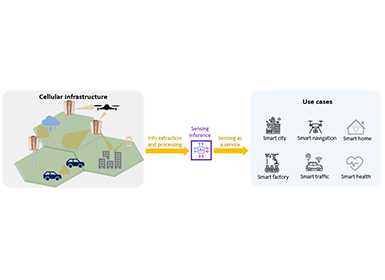Communications
eSIM and the Latest eSIM V3.0 Release
Consumer eSIM v3.0 Specification Released by GSMA
What is eSIM?
The traditional removable SIM (Subscriber Identity Module) card (hereafter 'SIM card') has played a fundamental role to securely store subscription data and credentials which are used to authenticate a device accessing the mobile network. SIM card is issued by a mobile carrier and an end user needs to insert the SIM card into a device to access the mobile carrier’s network.
The embedded SIM, or eSIM, is a programmable SIM card which is soldered inside a device. To use an eSIM to access a mobile carrier's network, a "Profile" needs to be downloaded from a Profile Server (so-called SM-DP+) to the eSIM inside the device as shown in Figure 1 (right). Profile is a software package containing subscription data and credentials that were originally defined to be stored inside a classical SIM card, and a Profile installed on an eSIM plays the same role as a classical SIM card.
Furthermore, a single eSIM is capable of holding multiple Profiles (up to its memory capacity) and the end user can manage (e.g., enable, disable, or delete) the installed Profiles via the device UI. Once a Profile is enabled, the eSIM, with the enabled Profile, operates as a SIM card.
With these fully digitalized characteristics, the eSIM provides greatly enhanced user experience by allowing users to subscribe and activate mobile services in a fully online manner without having to visit an operator shop to sign up a subscription and get a SIM card.

Figure 1. Removable SIM card vs. eSIM
GSMA eSIM Standards
GSMA (GSM Association) was founded in mid 1990s to encourage the use of GSM technology, and became a global organization which has more than 1,100+ member companies and provides industry-wide standards including eSIM.
In 2016, GSMA published eSIM V1 standard (hereafter 'eSIM V1') for the use of eSIM in consumer devices, especially for companion devices such as smart watches. eSIM V1 only supports the installation of only a single Profile on an eSIM, considering this specific device category. With eSIM V1-equipped device, to switch from one to another Profile, the existing Profile on the eSIM has to be deleted before installing a new one.
Later, eSIM V2 standard (hereafter 'eSIM V2') was released to support the use of eSIM in smartphones as well as in companion devices. In consideration of smartphone use cases, it allows for a user to install more than one Profile on an eSIM and manage them via device UI. Most of the eSIM devices in the market today are based on eSIM V2.
The procedure of remotely provisioning a Profile into an eSIM is called as "Remote SIM Provisioning" (RSP) in the GSMA eSIM specifications, and Figure 2 illustrates the overall RSP architecture.

Figure 2. Overall RSP architecture [1]
RSP architecture consists of the following four main components:
• SM-DP+ (Subscription Manager - Data Preparation+): a Profile server owned and controlled by each operator
• SM-DS (Subscription Manager - Discovery Server): a centralized discovery server to help a device find the SM-DP+ server holding a Profile for it
• LPA (Local Profile Assistant): a software component on the device to manage Profiles on the eSIM
• eUICC (embedded Universal Integrated Circuit Card): the standard terminology of eSIM, in particular meaning the "physical eSIM chipset"
Recently, GSMA published eSIM V3 (hereafter 'eSIM V3') last October [2], which provides new features improving user experiences with eSIM. More specifically, eSIM V3 introduces 'eSIM Device Change' and 'Multiple Enabled Profiles' as its key features.
Consumer eSIM V3 Key Features
<eSIM Device Change>

Figure 3. eSIM V3 Device Change
With a classical SIM card, when a user needs to change from the old device to a new one with the same subscription, she/he can simply do it by moving the SIM card from the old device to the new device, without any assistance from the carrier. With an eSIM V2 device, however, a user needs to contact the carrier's online/offline customer care center to request for the device change, and then the carrier will provide a new Profile to be downloaded to the new device and deactivate the existing Profile on the old device. This is probably the only worse user experience of eSIM compared to the classical SIM card as of eSIM V2.
In order to improve the user experience of the eSIM device change, GSMA has standardized 'Device Change' feature in eSIM V3, which allows a device manufacturer to provide a standardized means for a user to change her/his eSIM devices using a function provided by the device, without having to contact the carrier's customer care center as in eSIM V2. In eSIM V3 Device Change, on behalf of the user, the device conducts necessary communication and integration with the carrier's relevant servers in a standardized way as illustrated in Figure 3.
<Multiple Enabled Profiles (MEP)>

Figure 4. Dual-SIM support (eSIM V2 vs. eSIM V3 with MEP)
eSIM V2 supports installation of multiple Profiles in an eSIM as explained above. However, it has a restriction that only one Profile can be enabled at a given time, and hence, it cannot enable multiple Profiles simultaneously. As a consequence, most eSIM V2 devices in the market provide Dual-SIM functionality with a combination of eSIM and physical SIM card as illustrated in Figure 4 (left).
On the other hand, eSIM V3 devices will be able to provide Dual-SIM functionality with eSIM only as shown in Figure 4 (right), by taking advantage of the MEP (Multiple Enabled Profiles) feature defined in eSIM V3 that allows a device to enable more than one Profile at a time. The MEP feature, in this aspect, is expected to accelerate the deployment of eSIM-only devices in the market.
GSMA has collaborated with ETSI (European Telecommunications Standards Institute) to standardize MEP feature as the interface between a modem and an eSIM also needs to be updated, under the scope of ETSI standards. ETSI has defined a new multiplexing mechanism for that interface to support GSMA eSIM MEP feature [3].
Samsung’s eSIM History
In February 2016, Samsung launched Gear S2 classic 3G in the market as the world first device equipped with an eSIM compliant to GSMA eSIM V1 [4]. Starting with this, Samsung continues to roll out various eSIM-enabled wearable devices and smartphones in European and North American markets.
In August 2022, Samsung released Galaxy Z Fold4 and Flip4 as its first eSIM-enabled smartphones in Korea. Korean carriers also started their support for eSIM smartphone activation in September 2022, ushering in a new mobile era with eSIM in Korea.
Samsung Research has been actively involved and leading GSMA eSIM standardization from eSIM V1 to V3, and also contributing for successful commercialization of Samsung eSIM products. Samsung Research will continue developing innovative eSIM technologies to provide enhanced user experiences and values with future eSIM devices.
References
[1] GSMA SGP.22 Technical Specification v2.4 <https://www.gsma.com/esim/resources/sgp-22-technical-specification-v2-4/>
[2] GSMA SGP.22 Technical Specification v3.0 <https://www.gsma.com/esim/resources/sgp-22-v3-0/>
[3] ETSI News and Press Releases: New ETSI specification allows single UICC to support the use of multiple applications simultaneously
<https://www.etsi.org/newsroom/press-releases/2134-2022-10-new-etsi-specification-eliminates-the-need-for-physical-sims>
[4] Samsung Newsroom website: Samsung to Release Gear S2 classic 3G with GSMA Compliant eSIM
<https://news.samsung.com/global/samsung-to-release-gear-s2-classic-3g-with-gsma-compliant-esim>






